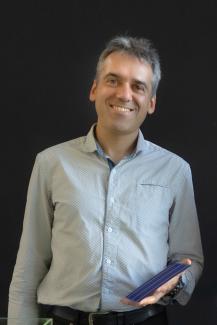Five scientists from the Université Paris-Saclay community awarded an ERC Synergy Grant
On 6 November, the European Research Council announced the 66 projects selected for the 2025 Synergy Grants. Bringing together 239 international scientists, these projects will receive a total of €684 million in funding. Among the awardees, five are members of the Université Paris-Saclay community.
CLIMPEAT
Led by Philippe Ciais, researcher at the Laboratoire des sciences du climat et de l’environnement (LSCE – Univ. Paris-Saclay/UVSQ/CEA/CNRS), together with Gustaf Hugelius (Stockholm University, Sweden), Pierre Friedlingstein (University of Exeter, UK), and Christina Biasi (University of Innsbruck, Austria), the project CLIMPEAT - Northern Peatlands in the Face of Climate Warming and Abrupt Changes - aims to improve our understanding of northern peatlands and to quantify the impact of climate change on these ecosystems. Northern peatlands contain enormous stocks of carbon and nitrogen that are vulnerable, and their release through abrupt changes could amplify global warming by emitting CO₂ and methane.
The most recent IPCC report concluded that peatlands, permafrost, and wildfires are major climate feedbacks still absent from current Earth System Models (ESMs). CLIMPEAT aims to address this critical knowledge gap by leveraging synergistic expertise in mapping, remote sensing, biogeochemistry, process-based modelling, and coupled climate and peatland dynamics projection.
3Stops2Go
Led by Olivier Namy, CNRS Research Director and Head of the Genomics, Structure and Translation team at the Institut de biologie intégrative de la cellule (I2BC - Univ. Paris-Saclay/CEA/CNRS), together with Leos Valasek (Institute of Microbiology of the Czech Academy of Sciences, Czech Republic), Julius Lukes (Biology Centre, Czech Academy of Sciences, Czech Republic), and Mark Osborn (University of Minnesota, United States), the awarded project led by this team is entitled 3Stops2Go, Three Stop Codons to Get Over to Flourish.
UltiMatePV
Led by Stéphane Collin, CNRS Research Director at the Centre de nanosciences et de nanotechnologies (C2N – Univ. Paris-Saclay/CNRS/Univ. Paris-Cité) and author of a guide and a comic book aimed at informing citizens about photovoltaic solar energy, together with Stefan Glunz (University of Freiburg, Germany) and Christophe Ballif (École polytechnique fédérale de Lausanne, Switzerland), the project UltiMatePV, Ultimate Photovoltaics, seeks to understand how to make solar cells both more efficient and more material‑economical. To address this question, Stéphane Collin will focus in particular on mechanisms at the nanometre scale: light absorption, charge transport and collection, the impact of defects, and so on. By trapping light within an ultrathin layer, his work has, for example, demonstrated that the thickness of a solar cell can be reduced by a factor of ten.
UniCIPS
Led by Kirone Mallick, permanent physicist at the CEA’s Institut de physique théorique (IPhT - Univ. Paris-Saclay/CEA/CNRS), together with Olivier Bénichou, CNRS Research Director at the Laboratoire de Physique Théorique de la Matière Condensée (LPTMC – CNRS/Sorbonne Univ.), Aurélien Grabsch, CNRS researcher at LPTMC, and Benjamin Doyon (King’s College London, UK), the project UniCIPS, Universal Equation for Non-Equilibrium Correlations in Interacting Particle Systems, aims to discover a universal law describing the behaviour of interacting particle systems when they are out of equilibrium - that is, when they are continuously exchanging matter or energy with their environment. Although such systems are ubiquitous, they remain poorly understood. The UniCIPS researchers rely on simple models, such as the symmetric exclusion process, to explore the fundamental mechanisms of transport and particle correlations. They have recently made a breakthrough, revealing, for certain models, the existence of a unique closed-form equation capable of describing all these correlations, thereby radically simplifying a problem that was previously intractable. The project seeks to extend this discovery to all systems, whether diffusive, ballistic, or of any dimensionality, in order to establish a unified theoretical framework for non-equilibrium physics.
Led by an international team combining expertise in statistical physics, integrability, and hydrodynamics, UniCIPS has the potential to transform the understanding of collective transport and open new perspectives for the science of complex systems.
WePhICom
Led by Marco Di Renzo, CNRS Research Director at the Laboratoire des signaux et systèmes (L2S - Univ. Paris-Saclay/CentraleSupélec/CNRS) and Highly Cited Researcher, together with Giuseppe Caire (Technical University of Berlin, Germany), Andrea Alù (CUNY Advanced Science Research Centre, United States), and Christoph Studer (Swiss Federal Institute of Technology Zurich, Switzerland), the project WePhICom - Waves, Physics, Information, and Computation aims to rethink wireless communications and make data transmission more energy-efficient. The group will explore a new approach to wireless communication that significantly reduces energy consumption and processing complexity. Over the next six years, the project will investigate how electromagnetic waves can be processed more efficiently to enable low-emission data transmission.
With a duration of six years and a maximum funding of €10 million, the ERC Synergy Grants are intended for groups of two to four scientists from member or associated countries, pursuing ambitious research projects at the frontiers of knowledge on questions that could not be solved individually.





